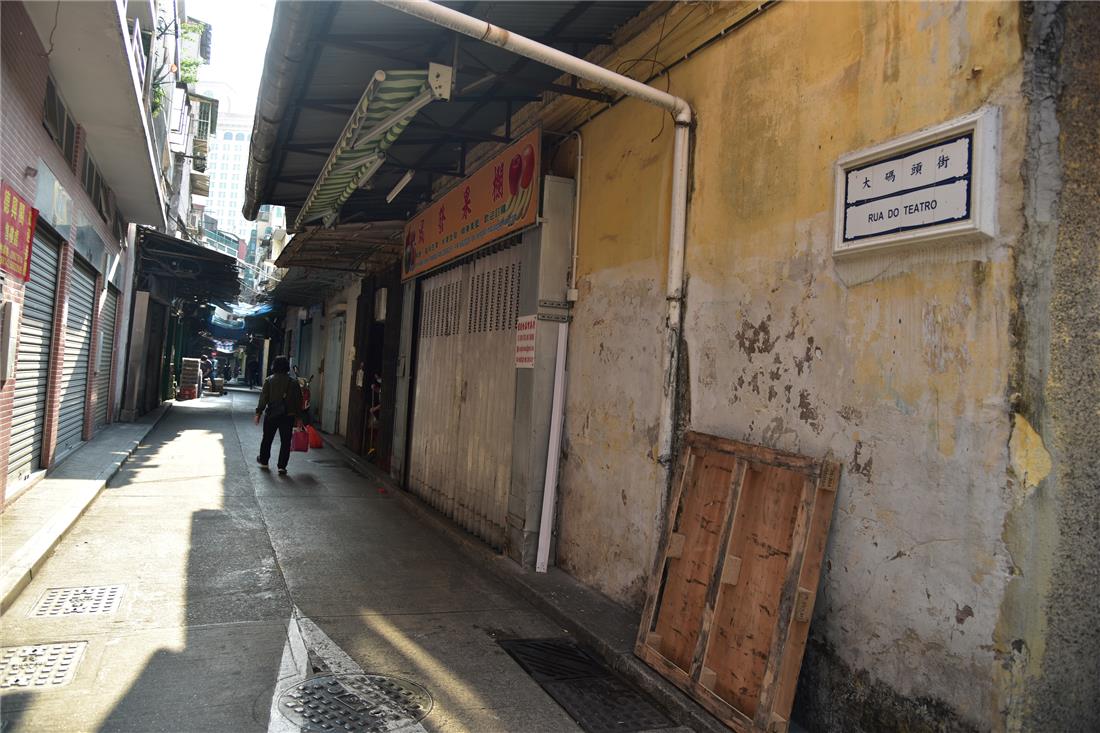
Rua do Teatro
Running northwest-southeast, Rua do Teatro joins Rua da Tercena in the east and Rua do Bispo Enes in the west, with Rua de Cinco de Outubro going right across the middle of it. It is about 148 metres long and 4 to 5 metres wide.
The earliest record of the road can be found in “Cadastro das Vias Públicas de Macau” (Cadastre of Public Roads of Macao) published in 1874. The road name in Portuguese, “Rua Do Teatro”, can be translated into “street of the theatre” in English, differing vastly from the Chinese version “大碼頭街” (literally “street of the port”). Is it because the road was once famous for theatres? Research has revealed that the Chinese name “大碼頭街” is derived from “Praia Pequena” in Portuguese, meaning “small beach”. Located near the sea, this road is referred to by the Portuguese as a “small beach”. The location of Rua do Teatro was an important port, enjoying a reputation as high as Nam Van.
The road is lined with more than ten fruit markets, which is the most significant feature of it, such as “Frutas Iao Kei”, “Frutas Tong Vo Chan”, and “Kuong Lei Frutas”. The Chinese term “果欄” is a common name for “wholesale fruit markets” used in the Pearl River Delta Region. Fruit markets in Macao appeared as late as the 1870s around Rua do Teatro and Rua da Tercena. About ten metres from the east end of the road, there is a small “Fok Tak Chi”, a temple dedicated to the God of Earth.
The earliest record of the road can be found in “Cadastro das Vias Públicas de Macau” (Cadastre of Public Roads of Macao) published in 1874. The road name in Portuguese, “Rua Do Teatro”, can be translated into “street of the theatre” in English, differing vastly from the Chinese version “大碼頭街” (literally “street of the port”). Is it because the road was once famous for theatres? Research has revealed that the Chinese name “大碼頭街” is derived from “Praia Pequena” in Portuguese, meaning “small beach”. Located near the sea, this road is referred to by the Portuguese as a “small beach”. The location of Rua do Teatro was an important port, enjoying a reputation as high as Nam Van.
The road is lined with more than ten fruit markets, which is the most significant feature of it, such as “Frutas Iao Kei”, “Frutas Tong Vo Chan”, and “Kuong Lei Frutas”. The Chinese term “果欄” is a common name for “wholesale fruit markets” used in the Pearl River Delta Region. Fruit markets in Macao appeared as late as the 1870s around Rua do Teatro and Rua da Tercena. About ten metres from the east end of the road, there is a small “Fok Tak Chi”, a temple dedicated to the God of Earth.
Last Update :
Please use Chrome.
© Municipal Affairs Bureau, All rights reserved
Please use Chrome.
© Municipal Affairs Bureau, All rights reserved










